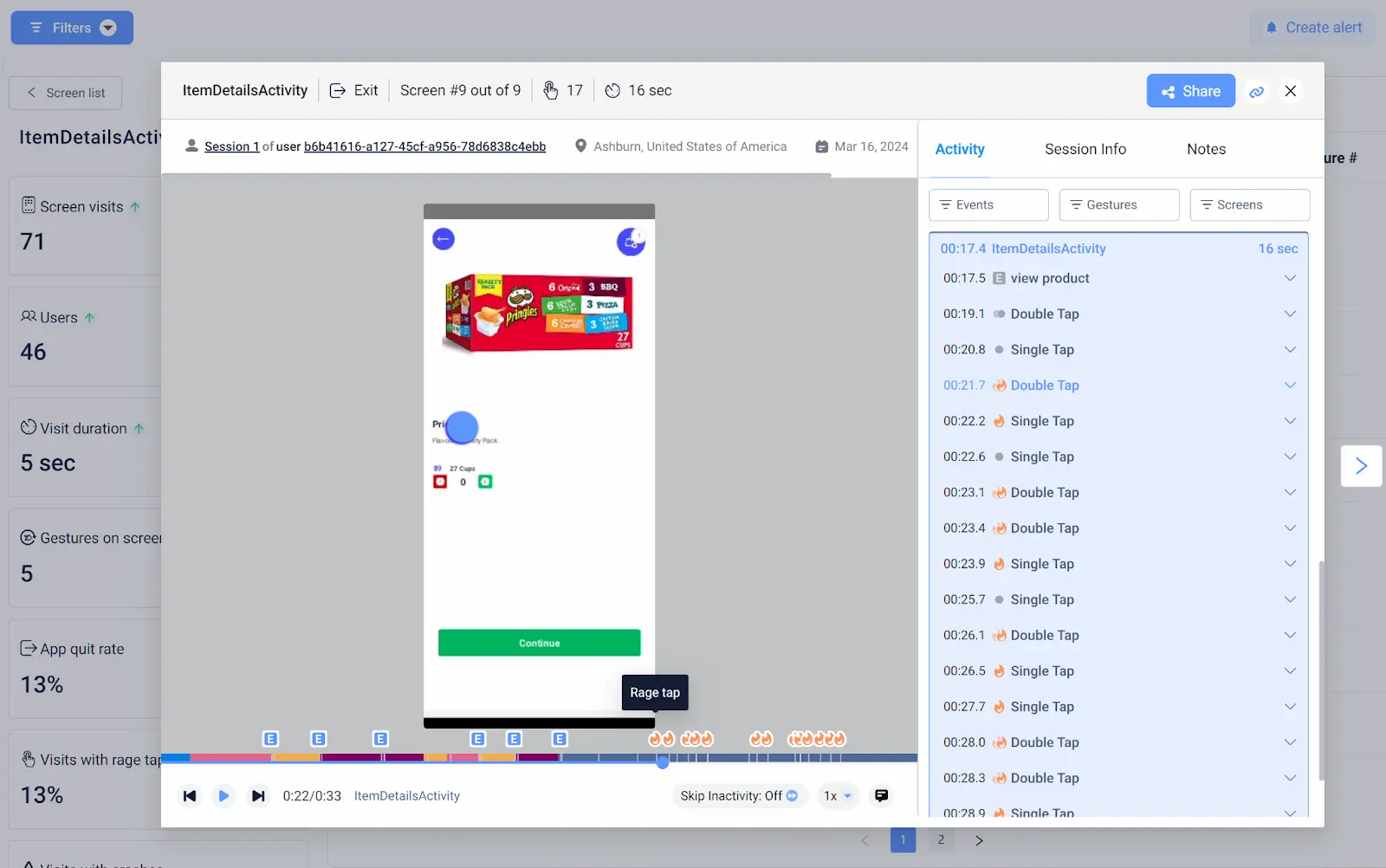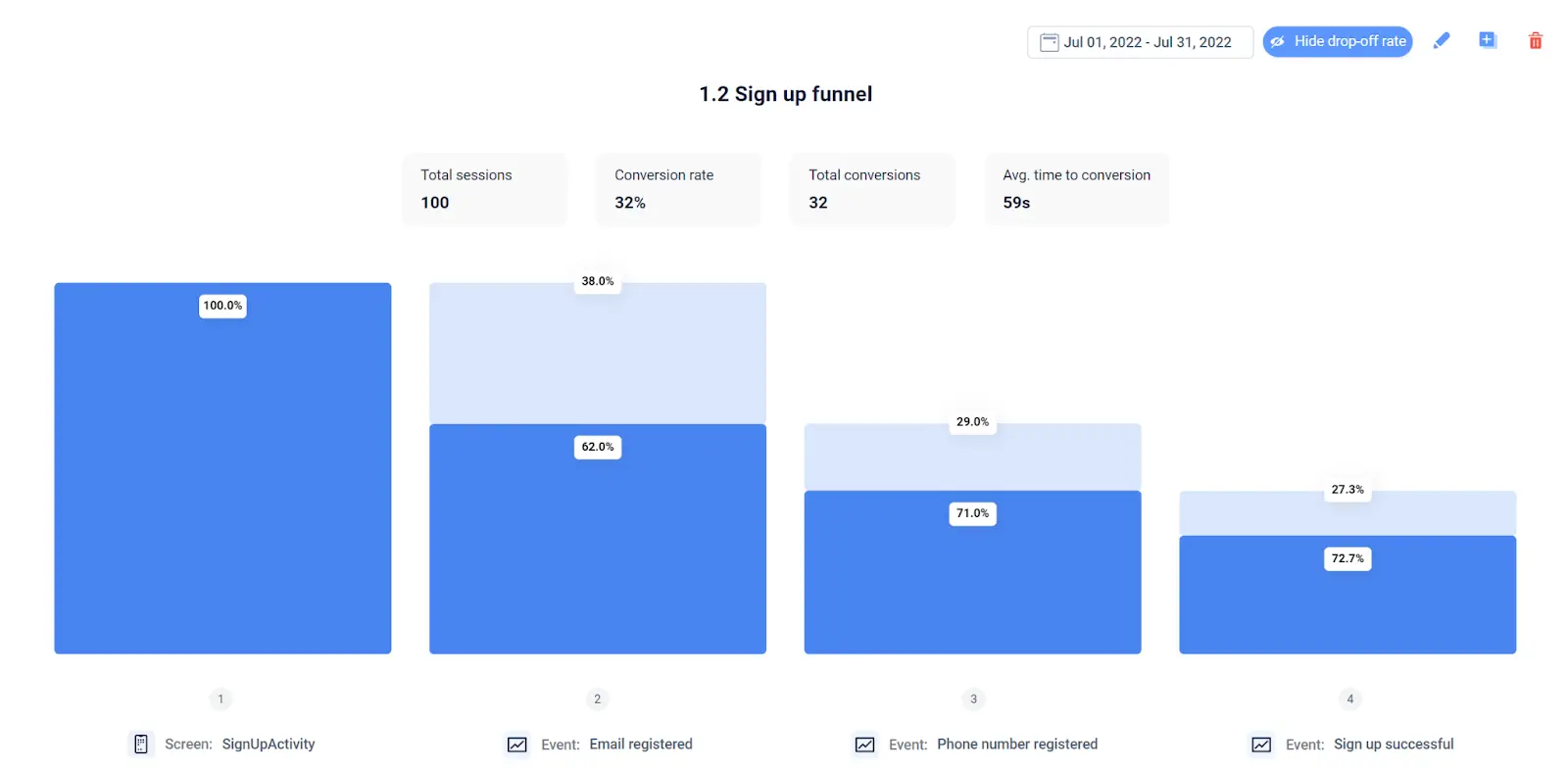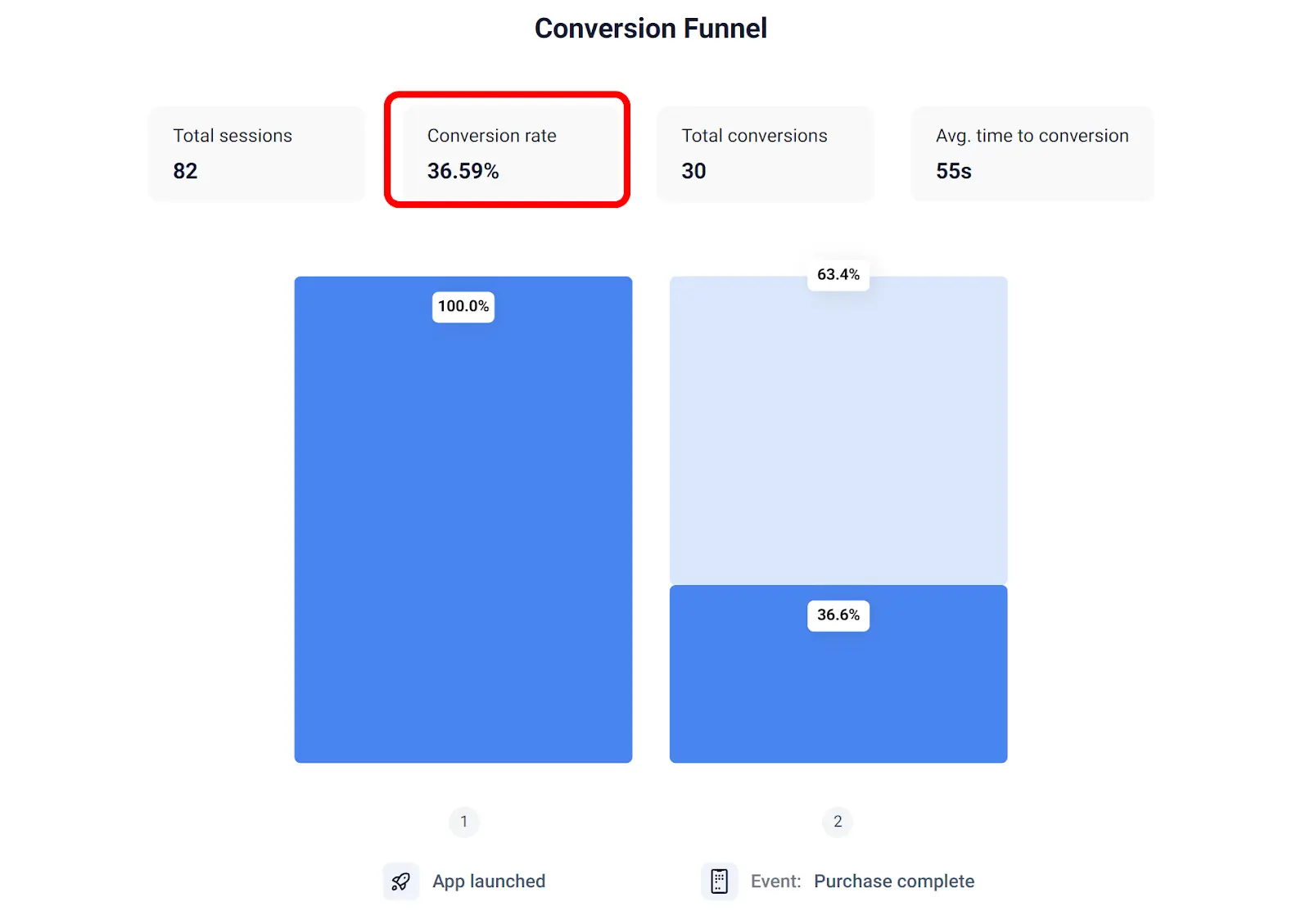Back to blog
5 MIN READ
Conversion Funnel Analysis - How to Spot and Fix Drop-offs
PUBLISHED
16 January, 2025

Product Analytics Expert
Need help analyzing your conversion funnel?
Realistically, the chances of converting every prospect to a customer are low. However, mobile app teams must be wary of low conversion rates, which are often a strong indication of a “leaky” conversion funnel.
When a conversion funnel is leaky, potential customers will drop off at various stages of their journey. Funnel analysis is one of the most effective ways to identify and fix these leaks to optimize conversion rates.
In this UXCam guide, we’ll explore what conversion analysis is and how you can perform one to improve your conversion rates.
Why listen to us?
We have first-hand experience in analyzing and optimizing conversion funnels. Using our insights, our clients, like Costa Coffee, increased their app user registrations by 15%.
Our solutions combine quantitative and qualitative data to give product managers a deep understanding of user behavior, motives, and frustrations. Clients can use this to find the precise areas that need to be targeted for an improved user experience.
Summary - Key steps for conversion funnel analytics
| Steps | Description |
|---|---|
| Outline the User Journey | Map the user journey from first contact to the final desired conversion. |
| Identify Drop-off Points | Use analytics tools to pinpoint stages where users disengage or drop off. |
| Segment Users | Group users by behavior or demographics to understand different conversion paths. |
| Track Conversion Rates | Measure percentage progress at each funnel stage to locate weak conversion areas. |
| Optimize the Funnel | Test and refine UI, UX, and content to improve progression through the funnel. |
What is conversion funnel analysis?
Before we explain conversion funnel analysis, let’s quickly understand what a conversion funnel is. It’s a map of a user or customer’s journey, from finding out about your product or app to taking the desired action (e.g., making a purchase).
A traditional conversion funnel has four stages:
Awareness: A user discovers your app
Interest: You engage them to nurture their interest and encourage further exploration
Desire: They see your app as a solution to their problem
Conversion/Action: They take the desired action, such as making a purchase
Conversion funnel analysis is the process of examining each stage of the journey. It aims to monitor, evaluate, and identify which part of the funnel needs optimization to ensure the user reaches the end of the funnel and takes the desired action.
Why is conversion funnel tracking important?
Conversion funnel analysis is important for several reasons:
Identifying bottlenecks
By identifying bottlenecks in user journeys, product teams can address specific issues causing the users to drop off. By doing this, conversion rates will be improved.
Enhancing user experience
Analyzing the funnel provides insights into the user journey. Improving weak points in the funnel can lead to a smoother, more satisfying user experience and, ultimately, better user engagement and retention.
Facilitates segmentation and targeting
Conversion funnel analysis provides valuable insights into various user segments and their behaviors. App teams can use this knowledge to craft more targeted and personalized marketing strategies.
Measuring performance
Funnel analysis clearly shows how well different stages of the marketing and sales process are performing, allowing for better performance tracking and decision-making.
Informed decision-making
A business decision is only as good as the data backing it. Detailed insights from funnel analysis enable data-driven decisions, reducing guesswork and increasing the effectiveness of business strategies.
How to perform a conversion funnel analysis
Step 1: Outline the user journey
Start by creating a detailed map of the user journey, from when they spot your app until they take the desired action or drop off the funnel. Then, identify the touchpoints or specific interactions they make in each stage.
For example, if you have an e-commerce app where users can buy eco-friendly packaging products, their key touch points might include:
Landing/sign-in screen
Product catalog
Shopping cart
Checkout screen
Using UXCam, you can map out the entire user journey by tracking their interactions from the first app launch to the final conversion. Our session recordings and heatmaps visualize how users navigate your app, making identifying key touchpoints and stages easier.

Step 2: Identify drop-off points
Now that you have a projection of a perfect user journey, we can measure and analyze it. The goal is to track where users are dropping off instead of going all the way to the end to take the desired action. You can use funnel analysis tools to do this.
For example, UXCam’s funnel analytics feature offers detailed insights into each step of the conversion process. This allows you to easily create a funnel and track your users to see exactly where they drop off.

Step 3: Segment users based on how and where they convert
Next, divide your users into segments based on their behavior and conversion paths. You can have different patterns for each user, considering not every user will take the same route to conversion.
UXCam can help you streamline this step of your conversion funnel analysis by creating segments for users based on the specific actions that they take within your app.
This gives you insights into the different ways your users convert. With that information, you can optimize your app to favor the user behaviors and journeys that lead to more conversions.
Here’s an example of a conversion funnel for an app registration process in UXCam, showing the different pathways users take to complete the desired action (registration).

Step 4: Track conversion rates
You can even dig deeper to determine the conversion rates at each funnel stage. This data helps you understand the effectiveness of each stage and identify the areas that need improvement. In other words, you know where users are moving forward and where they’re dropping off.
Using UXCam, you can analyze conversion rates by tracking them for each stage of the conversion process.

Step 5: Perform funnel optimization
Finally, based on your analysis, implement changes to optimize the funnel.
A high conversion rate from Step 4 means the conversion funnel effectively guides users through the desired sequence. Conversely, a low conversion rate suggests potential usability issues or friction points that hinder user progress.
This could involve A/B testing different app elements, such as UI/UX, Call-to-Action (CTA) buttons, content, and loading times. 58% of companies are currently using this conversion method.
Best practices for analyzing a conversion funnel
Here are some best practices for analyzing a conversion funnel:
Use visualizations to understand data: Leverage visual tools like funnel charts and heatmaps to understand user behavior better and identify bottlenecks.
Regularly review and update your funnel: Conversion funnels are not static. Review your funnel’s performance regularly and update it based on new data, user feedback, and changing market conditions.
Focus on user feedback: Collect and analyze user feedback to understand their pain points and preferences. Use this information to make improvements to your funnel.
Consider external factors: External influences, such as holidays, special events, or economic conditions, can significantly impact user behavior. Consider these when interpreting your conversion funnel analysis data.
Use UXCam to simplify your conversion analysis
An effective conversion channel is a necessary part of getting your app users to take the desired actions. But, this isn’t always easy to do yourself.
Fortunately, UXCam helps you analyze and understand your user journey and conversion path. It equips you with everything you need to track and optimize your conversion rate, making it easier to turn users into paying customers.
Request a free demo or start your free trial today to start improving your conversion funnel.
You might also be interested in these;
Conversion Funnel Optimization - A Comprehensive Guide
What is a Website Conversion? & 16 Strategies to Improve It
Funnel analysis examples: How to improve app conversions
Funnel drop-off rate - Benchmarks & strategies to improve
Top 5 ecommerce funnel metrics and how to analyze them
AUTHOR

Tope Longe
Product Analytics Expert
Ardent technophile exploring the world of mobile app product management at UXCam.
What’s UXCam?
Related articles
Conversion Analysis
Flutter Session Replay & Recording for Apps: UXCam
Optimize your Flutter app's performance with UXCam's session recording and replay tool. Easy integration, optimized features, and strong...

Jonas Kurzweg
Product Analytics Expert
Conversion Analysis
What is Mobile Analytics? Guide, Tools & Best Practices
Mobile analytics take the guesswork out of understanding how users interact with your app. Learn what mobile analytics is, why it's important, and how it differs from web...

Jonas Kurzweg
Product Analytics Expert
Conversion Analysis
Mobile App Session Replay: Ultimate Guide 2025
Unleash the power of session...

Jonas Kurzweg
Product Analytics Expert


